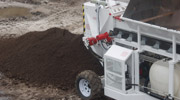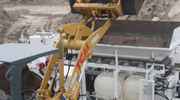

How our process works. Previously excavated soil is deposited by a conventional front-end loader into the hopper at the top of the mobile and self-propelled machinery. Very large debris, such as rock or concrete, is usually screened off at the hopper opening. From the hopper, the soil is transferred in a regulated flow to a processing mill. The mill impacts and shreds the soil, while blending a treatment solution (chemical, biological, or both), along with air and moisture, into the soil using a proprietary method. The contaminant molecules in the soil are already being degraded or neutralized by the time the soil emerges from the processing mill.
Why our system works. There is, in nature a wide variability in soil conditions and soil content, even within small distances. This is the principal barrier to effective and efficient remediation of contaminated soil. Our process is designed to eliminate this variability in the soil while introducing one or more chemical or biological reagent(s) known to degrade and/or neutralize the specific contaminants in that soil. We therefore can tailor the choice of chemical and/or biological reagent to the specific type and severity of contamination, and to the specific soil conditions at a site. Second, the process reduces the soil to a fine particle state, maximising the surface area, in order to maximize access to the contaminant molecules. Third, the process ensures the even distribution of the reagent(s) throughout this soil matrix, and the degradation/neutralization is completed before the soil loses its homogenous and fine particulate composition. Finally, to improve speed and efficiency, the process creates a relatively high level of air entrainment in the soil, along with a carefully calibrated level of moisture content.
Treatment agents. Our process is designed to work with any chemical reagent or biological product that is or can be delivered in an aqueous solution. The choice of what to use in a given project is determined from analysis of the contaminant or combination of contaminants in the soil, and from analysis of the soil composition, moisture content, pH, etc. For example, commercially available products that are commonly used to degrade hydrocarbons as part of various cleaning and degreasing applications, can be adapted successfully by our process. Other products that can be adapted are based on a chemical principle known as Fenton's Reagent Chemistry. FRC provides for direct oxidation -- release of nascent oxygen - via an exothermic reaction between a peroxygen and a catalyst. The exothermic reaction as well as oxygen release, dependent upon catalyst, degrades the hydrocarbon molecule to its carbon and hydrogen elements. The nascent oxygen reacts with these elements to form benign compounds (for example, in the case of gasoline, the by-products are water and carbon dioxide). Chemical reactions based on this chemistry are reliable and predictable, once the proper environment has been created.
Metals (for example, soluble lead) are neutralized by chemical bonding at the molecular level, resulting in by-products that are stable and benign. We apply a variety of products that release cultured microbes proven to degrade and/or neutralize various types of contaminants. In all known cases, these are naturally occurring biological organisms that have been found to thrive in environments where these contaminants have been introduced by man-made events or by natural causes.
We have the capacity to remediate 160 metric tonnes per hour per machine and have the capacity to deploy more than one machine per site. Actual throughput will vary somewhat depending upon soil type, soil condition and moisture content. In many cases, the contaminant has been degraded and/or neutralized almost as soon as it exits the processing mill. In some cases, the degradation process must continue over a period of hours or a few days, to achieve the desired remediation level. When we rely on a biological product to provide most of the degradation/ neutralization, the process may take longer (up to a few weeks) to achieve the desired results.









